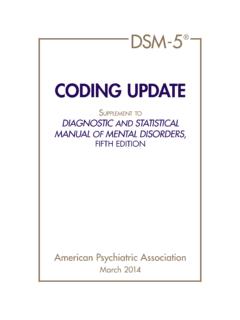Transcription of PRACTICE GUIDELINE FOR THE Treatment of Patients With ...
1 1 PRACTICE GUIDELINE FOR THE Treatment of Patients With acute stress Disorder and posttraumatic stress DisorderWORK GROUP ON ASD AND PTSDR obert J. Ursano, , ChairCarl Bell, Eth, Friedman, , Norwood, Pfefferbaum, , S. Pynoos, F. Zatzick, M. Benedek, , ConsultantOriginally published in November 2004. This GUIDELINE is more than 5 years old and has not yet been updated to ensure that it reflects current knowledge and PRACTICE . In accordance with national standards, including those of the Agency for Healthcare Research and Quality s National GUIDELINE Clearinghouse ( ), this GUIDELINE can no longer be assumed to be current.
2 The March 2009 GUIDELINE Watch associated with this GUIDELINE provides additional information that has become available since publication of the GUIDELINE , but it is not a formal update of the GUIDELINE is dedicated to Rebecca M. Thaler Schwebel (1972 2004), Senior Project Manager atAPA when this GUIDELINE was initiated. Becca s humor, generous spirit, and optimism will be 2010, American Psychiatric Association. APA makes this PRACTICE GUIDELINE freely available to promote its dissemination and use; however, copyright protections are enforced in full.
3 No part of this GUIDELINE may be reproduced except as permitted under Sections 107 and 108 of Copyright Act. For permission for reuse, visit APPI Permissions & Licensing Center at PRACTICE GuidelinesAMERICAN PSYCHIATRIC ASSOCIATIONSTEERING COMMITTEE ON PRACTICE GUIDELINESJohn S. McIntyre, ,ChairSara C. Charles, ,Vice-ChairDaniel J. Anzia, A. Cook, T. Finnerty, R. Johnson, E. Nininger, Summergrad, M. Woods, , Yager, AND COMPONENT LIAISONSR obert Pyles, (Area I)C. Deborah Cross, (Area II)Roger Peele, (Area III)Daniel J.
4 Anzia, (Area IV)John P. D. Shemo, (Area V)Lawrence Lurie, (Area VI)R. Dale Walker, (Area VII)Mary Ann Barnovitz, Hafter Gray, Saxena, Tonnu, Kunkle, , Senior Program ManagerAmy B. Albert, , Assistant Project ManagerLaura J. Fochtmann, , Medical EditorClaudia Hart, Director, Department of Quality Improvement and Psychiatric ServicesDarrel A. Regier, , , Director, Division of ResearchCopyright 2010, American Psychiatric Association. APA makes this PRACTICE GUIDELINE freely available to promote its dissemination and use; however, copyright protections are enforced in full.
5 No part of this GUIDELINE may be reproduced except as permitted under Sections 107 and 108 of Copyright Act. For permission for reuse, visit APPI Permissions & Licensing Center at of Patients With acute stress Disorder and posttraumatic stress Disorder3 CONTENTSS tatement of Intent .. 5 Guide to Using This PRACTICE GUIDELINE .. 6 Development Process .. 7 Introduction .. 9 Part A: Treatment Recommendations .. Summary .. System .. of Recommendations.. and Implementation of a Treatment Plan .. Assessment.
6 Of Psychiatric Management .. of Treatment Selection .. Treatment Strategies.. Clinical Features Influencing the Treatment Plan .. and Cross-Cultural Factors .. and Other Psychiatric Comorbidity .. of Previous Traumas .. Behavior .. and Suicidal Behaviors .. 38 Part B: Background Information and Review of Available Evidence .. Definition, Epidemiology, and Natural History .. Clinical Features .. Features .. Diagnosis .. History and Course .. and Synthesis of Available Evidence.
7 In Interpreting the Literature.. Interventions .. 63 Part C: Future Research Needs .. 67 Individuals and Organizations That Submitted Comments .. 70 References .. 71 Copyright 2010, American Psychiatric Association. APA makes this PRACTICE GUIDELINE freely available to promote its dissemination and use; however, copyright protections are enforced in full. No part of this GUIDELINE may be reproduced except as permitted under Sections 107 and 108 of Copyright Act. For permission for reuse, visit APPI Permissions & Licensing Center at 2010, American Psychiatric Association.
8 APA makes this PRACTICE GUIDELINE freely available to promote its dissemination and use; however, copyright protections are enforced in full. No part of this GUIDELINE may be reproduced except as permitted under Sections 107 and 108 of Copyright Act. For permission for reuse, visit APPI Permissions & Licensing Center at of Patients With acute stress Disorder and posttraumatic stress Disorder5 STATEMENT OF INTENTThe American Psychiatric Association (APA) PRACTICE Guidelines are not intended to be con-strued or to serve as a standard of medical care.
9 Standards of medical care are determined onthe basis of all clinical data available for an individual patient and are subject to change as sci-entific knowledge and technology advance and PRACTICE patterns evolve. These parameters ofpractice should be considered guidelines only. Adherence to them will not ensure a successfuloutcome for every individual, nor should they be interpreted as including all proper methodsof care or excluding other acceptable methods of care aimed at the same results. The ultimatejudgment regarding a particular clinical procedure or Treatment plan must be made by the psy-chiatrist in light of the clinical data presented by the patient and the diagnostic and treatmentoptions PRACTICE GUIDELINE has been developed by psychiatrists who are in active clinical prac-tice.
10 In addition, some contributors are primarily involved in research or other academicendeavors. It is possible that through such activities some contributors, including work groupmembers and reviewers, have received income related to treatments discussed in this guide-line. A number of mechanisms are in place to minimize the potential for producing biasedrecommendations due to conflicts of interest. Work group members are selected on the basisof their expertise and integrity. Any work group member or reviewer who has a potential con-flict of interest that may bias (or appear to bias) his or her work is asked to disclose this to theSteering Committee on PRACTICE Guidelines and the work group.










